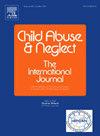受虐待儿童的不良童年经历和创伤症状:儿童和照顾者保护因素的作用
IF 3.4
2区 心理学
Q1 FAMILY STUDIES
引用次数: 0
摘要
在18岁以下的儿童中,大约58%的人报告经历过一次或多次不良童年经历(ACE)。暴露于ace对儿童的发育有重大影响,并增加了一生中身体和心理健康状况不佳的风险。弹性科学表明,儿童社会生态中的保护性因素可以减轻不良经历对结果的影响。目的本研究在接受虐待心理服务的儿童样本中,探讨个人和照顾者保护因素如何调节累积性不良经历和儿童创伤症状之间的关联。方法回顾性分析在儿童和青少年倡导中心就诊的71例8 ~ 17岁(M年龄= 12.6,SD = 2.5, 78.6%为女孩)的资料。参与者还完成了评估创伤症状和保护因素的调查问卷。结果分析发现,儿童的同伴支持感知、内在控制点、未来取向等个人保护因素(r = - 0.51, p < .001)和照顾者保护因素(r = - 0.39, p = 0.010)与创伤症状呈负相关。此外,儿童个人保护因素被发现可以缓和ace与创伤症状之间的关联(β = - 1.84, p = 0.036),这表明这些因素可以减轻累积ace的风险。照顾者保护因素没有调节这种关联(β = - 0.5, p = 0.700)。结论本研究强调了在创伤干预项目中嵌入人际和人际技能训练的重要性,并鼓励进一步研究保护因素在儿童发展不同阶段的影响。本文章由计算机程序翻译,如有差异,请以英文原文为准。
Adverse childhood experiences and trauma symptoms in maltreated children: The role of child and caregiver protective factors
Background
Among children under the age of 18, approximately 58 % report experiencing one or more adverse childhood experience (ACE). Exposure to ACEs is consequential for children's development and increases risk of poor physical and mental health outcomes across the lifespan. Resilience science suggests that protective factors within a child's social ecology can mitigate the impact of ACEs on outcomes.
Objective
The current study examines how personal and caregiver protective factors moderate the association between cumulative ACEs and child trauma symptoms in a sample of children receiving psychological services for maltreatment.
Methods
A retrospective file review of 71 participants aged 8 to 17 (M age = 12.6, SD = 2.5, 78.6 % girls) seen at a child and youth advocacy centre was conducted. Participants also completed questionnaires to assess trauma symptoms and protective factors.
Results
Analyses revealed that children's personal protective factors, such as perceived peer support, internal locus of control, and future orientation (r = −0.51, p < .001), as well as caregiver protective factors (r = −0.39, p = .010), were negatively correlated with their trauma symptoms. Furthermore, child personal protective factors were found to moderate the association between ACEs and trauma symptoms (β = −1.84, p = .036), suggesting that these factors mitigate the risk of cumulative ACEs. Caregiver protective factors did not moderate this association (β = −0.5, p = .700).
Conclusions
This study highlights the importance of embedding intrapersonal and interpersonal skills training in trauma-based intervention programs and encourages further research into the impacts of protective factors at different phases of child development.
求助全文
通过发布文献求助,成功后即可免费获取论文全文。
去求助
来源期刊

Child Abuse & Neglect
Multiple-
CiteScore
7.40
自引率
10.40%
发文量
397
期刊介绍:
Official Publication of the International Society for Prevention of Child Abuse and Neglect. Child Abuse & Neglect The International Journal, provides an international, multidisciplinary forum on all aspects of child abuse and neglect, with special emphasis on prevention and treatment; the scope extends further to all those aspects of life which either favor or hinder child development. While contributions will primarily be from the fields of psychology, psychiatry, social work, medicine, nursing, law enforcement, legislature, education, and anthropology, the Journal encourages the concerned lay individual and child-oriented advocate organizations to contribute.
 求助内容:
求助内容: 应助结果提醒方式:
应助结果提醒方式:


